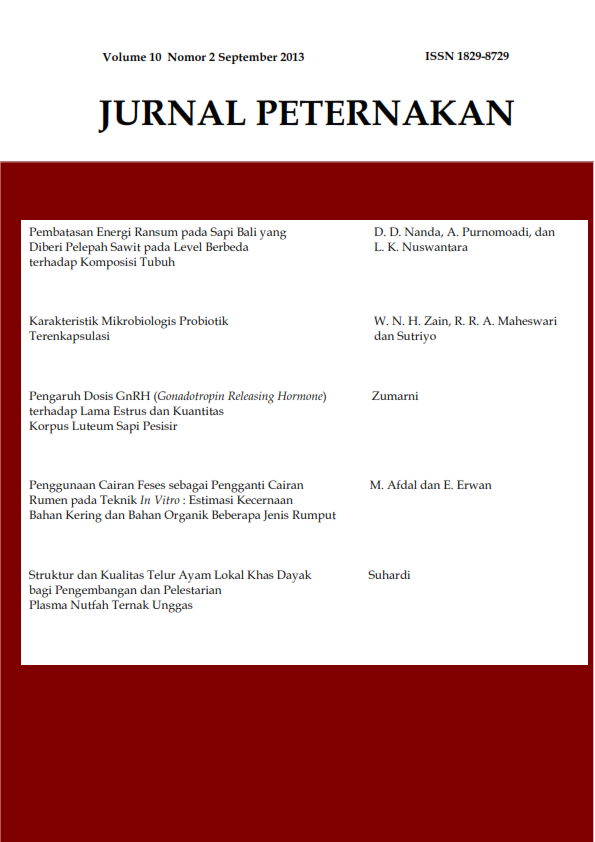PENGGUNAAN CAIRAN FESES SEBAGAI PENGGANTI CAIRAN RUMEN PADA TEKNIK IN VITRO : ESTIMASI KECERNAAN BAHAN KERING DAN BAHAN ORGANIK BEBERAPA JENIS RUMPUT
DOI:
https://doi.org/10.24014/jupet.v10i2.2320Keywords:
dry matter, faeces, in vitro, organic matterAbstract
The aim of this study was to reveal the potency of faecal inoculum added with sugar and urea in the in vitro technique to evaluate some grasses like Penisetum purpureum, rumput kumpeh, Setaria sphacelata dan Imperata cylindrica when compared with the rumen inoculum. The Tilley and Terry technique was applied in this study. The treatments in this experiment were rumen liquid (control), faecal inoculum, faecal inoculum + 2.5% (w/v) sugar, faecal inoculum + 2.5% (w/v) sugar and 2.5% (w/v) urea and faecal inoculum + 2.5% (w/v) urea for treatment A, B, C, D and E respectively. All grass samples were incubated with the treatments. Parameter measured were the digestibility of dry matter and organic matter. Result of these study showed that the digestibility of dry matter and organic matter of the four grasses were significant (P<0.05). Treatment A using rumen liquid was the highest in digestibility of dry matter and organic matter among other treatments.
Downloads
Published
Issue
Section
License
The Authors submitting a manuscript do so on the understanding that if accepted for publication, copyright of the article shall be assigned to Jurnal Peternakan and published by Fakultas Pertanian dan Peternakan Universitas Islam Negeri Sultan Syarif Kasim Riau as publisher of the journal.
Authors who publish with this journal agree to the following terms:
Authors automatically transfer the copyright to the journal and grant the journal right of first publication with the work simultaneously licensed under a Creative Commons (CC BY) that allows others to share the work with an acknowledgement of the work's authorship and initial publication in this journal.
Authors are able to enter into separate permission for non-exclusive distribution of the journal's published version of the work (e.g., post it to an institutional repository or publish it in a book), with an acknowledgement of its initial publication in this journal.
Authors are permitted and encouraged to post their work online (e.g., in institutional repositories or on their website) prior to and during the submission process, as it can lead to productive exchanges, as well as earlier and greater citation of published work (See The Effect of Open Access).

